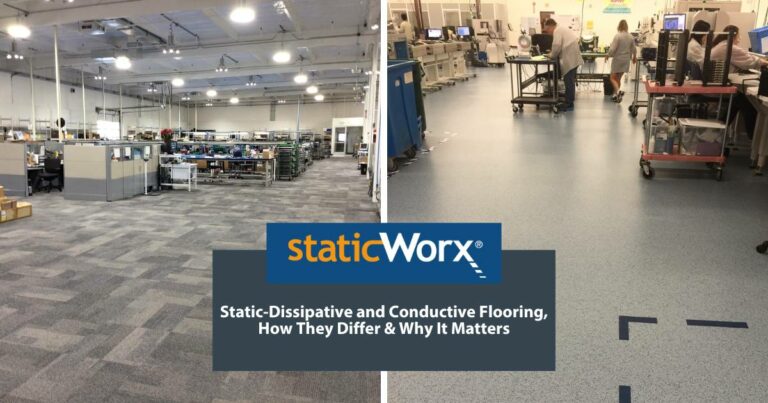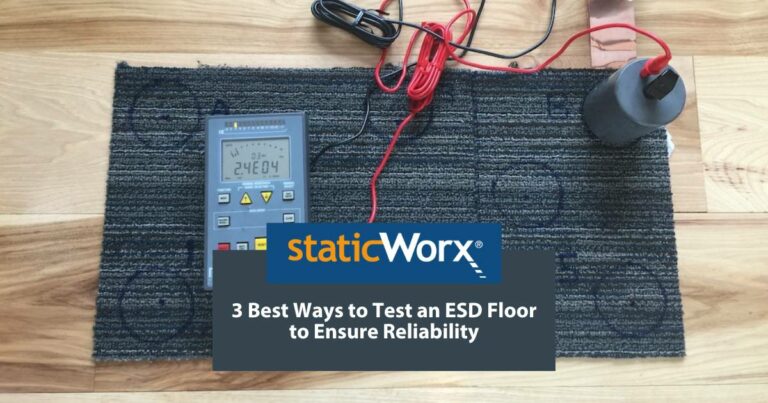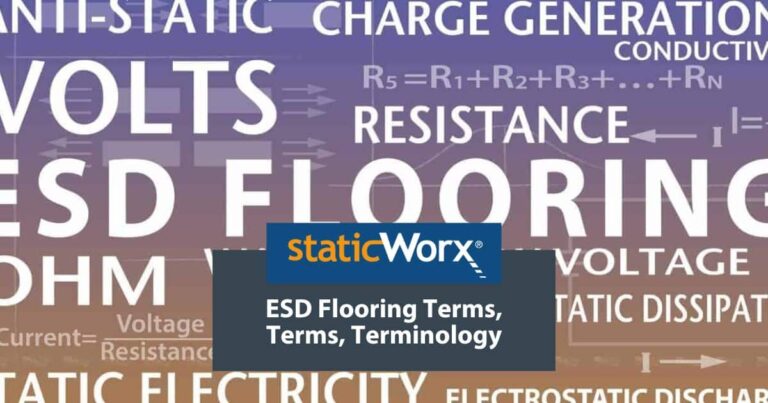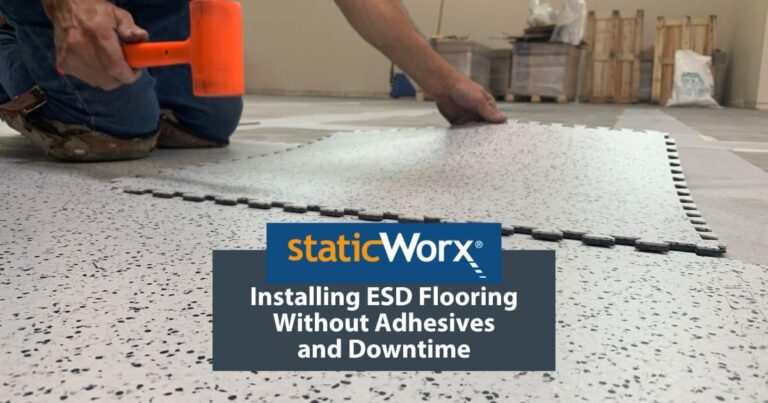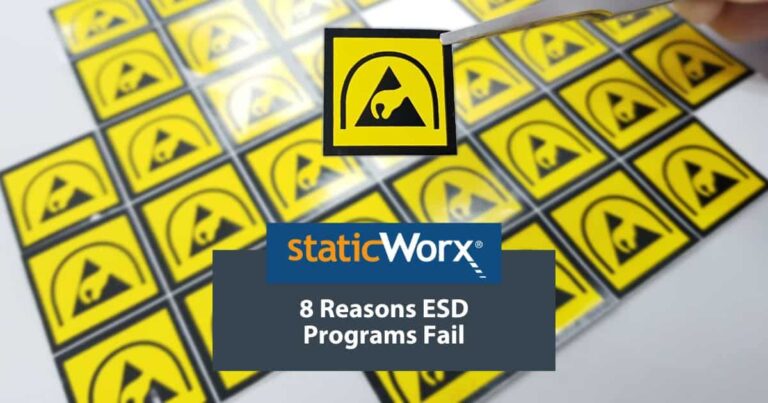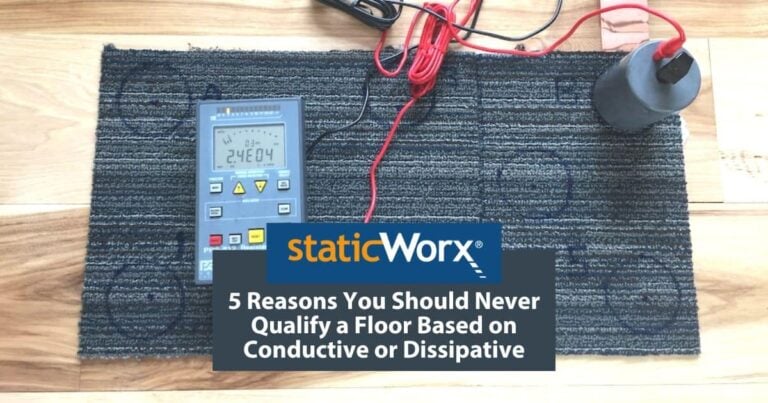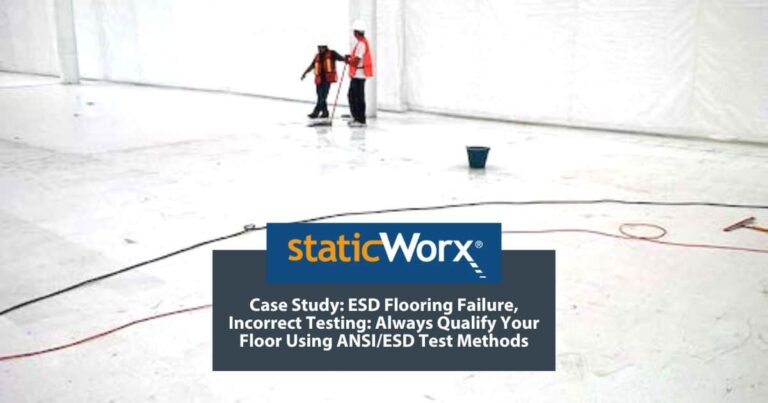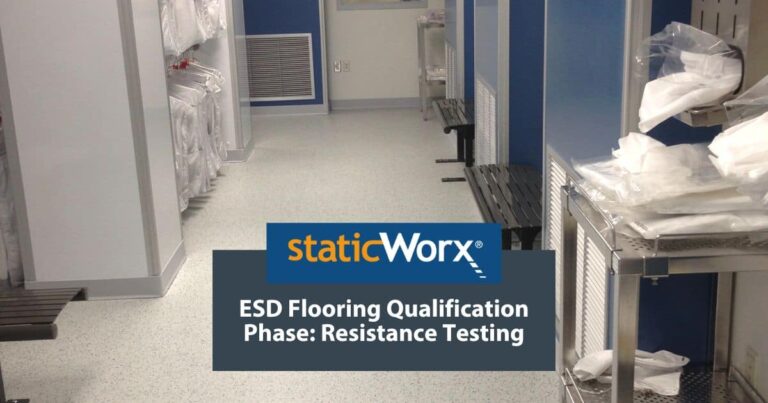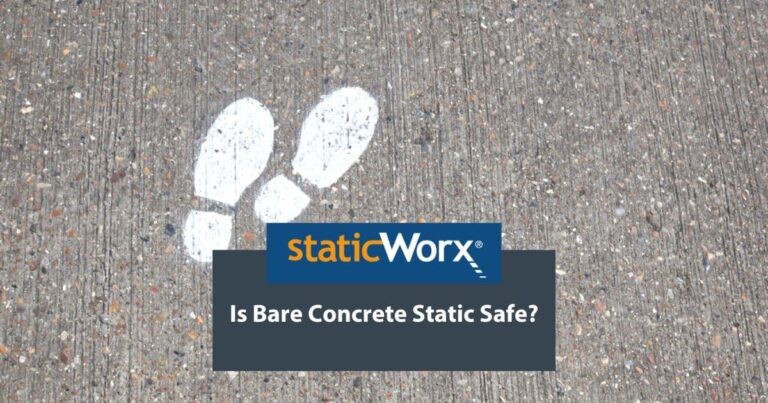Learn the differences between ESD solid vinyl tile and interlocking ESD tile. The post compares specs, installation, maintenance and intangibles.

Static-Dissipative or Conductive Flooring: Which is Right for You?
8 min read, 3 min video
When selecting electrostatic discharge (ESD) flooring for a facility that manufactures, handles or uses electronic equipment, there are two main options: conductive and static dissipative. Both are ESD floors, designed to prevent electrostatic discharge events that could potentially damage or destroy sensitive electronic devices or ignite explosives.
ESD flooring works by drawing static away from people and moving objects and discharging charges to ground. ESD floors are also antistatic, which means they prevent static charge generation; to be antistatic/prevent charge generation, some flooring materials, particularly ESD vinyl and epoxy, require the use of static-protective footwear.
Conductive and dissipative are both ESD floors, both draw charges away from people and moving objects and both discharge static to ground. So, how are they different?
Conductive and Static-dissipative: What’s the Difference?
People sometimes use the terms “conductive” and “static-dissipative” interchangeably. While conductive and dissipative floors are the same in that they both transport electricity or electrical charges, their electrical performance differs. Conductive and dissipative ESD floors differ in how quickly (conductive) or gradually (dissipative) the floor transports electrical charges through the thickness of the material to ground.
Conductive and static dissipative are categories of the broader term “ESD flooring.” The category a floor belongs in is determined only by its electrical resistance, measured with an ohm meter, following guidelines outlined in ANSI/ESD STM7.1.
Conductive floors measure < 1.0 x 10E6
While ANSI/ESD 20.20 provides no lower limit for electrical resistance, most electronics manufacturing and handling facilities only use floors measuring at or above 2.5 x 10E4.
Static-dissipative floors measure ≥ 1.0 x 10E6 and < 1.0 x 10E9.
Conductive or Dissipative: Which is Right for You?
When choosing an ESD floor, there are many factors to consider.
1. Industry and Application
Before choosing an ESD floor it’s important to consider the industry and type of work being done in the facility.
Facilities that manufacture munitions or explosives run the risk of fire or explosion as a static spark can ignite explosive materials. For personnel safety, these facilities prefer conductive, even highly conductive, flooring because they need a floor that quickly transports charges to ground.
Electronics manufacturing and handling facilities, cleanrooms, TRACON, labs and similar spaces generally prefer floors measuring within what we call “the Sweet Spot” – i.e., between 1.0 x 10E5 and 1.0 x 10E8 – i.e., a floor that is neither too fast nor too slow at transporting electrical charges. Some facilities managers prefer more conductive floors, but the majority do not choose floors measuring below 2.5 x 10E4, for safety reasons.
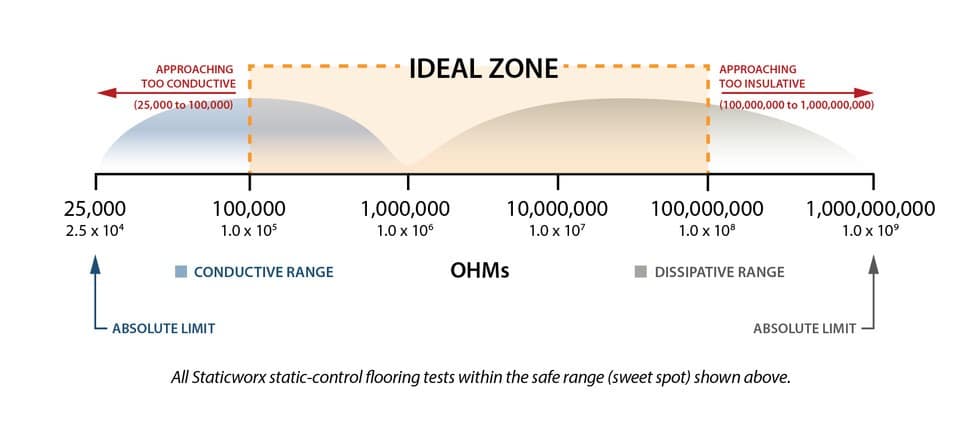
Industry standards require PSAPs, telecommunications, banks, government offices, data centers, media rooms, and similar end-user spaces to use dissipative flooring, measuring > 1.0 x 10E6 and < 1.0 x 10E9.
People working in end-user facilities are typically in routine contact with wired electrical equipment. Static-dissipative flooring transports electrical charges more slowly both to ground and across the surface of the floor. If an electrical component shorted, the floor would inadvertently become part of an electrical circuit. Electricity flows at a more controlled rate across a static-dissipative floor. Independent lab tests have shown that the risk of electrical shock is lower with static-dissipative than conductive flooring, making it a safer choice for personnel working in these types of facilities.
2. Electrical Standards
Resistance standards vary across industries and applications. Always choose flooring that meets standards for your industry.
ANSI/ESD S20.20, for electronics manufacturing and handling facilities, requires ESD flooring to measure < 1.0 x 10E9.
Motorola R56, for public safety and telecom, requires ESD flooring to measure > 1.0 x 10E6 and < 1.0 x 10E10.
ATIS 0600321, for network operator dispatch call centers, requires ESD flooring to measure > 1.0 x 10E6 and < 1.0 x 10E10.
FAA 019f, for the US Flight towers and facilities that use FAA equipment, requires resistance to read > 1.0 x 10E6 and < 1.0 x 10E9.
3. Footwear
Whether or not people in your facility wear special ESD-protective footwear has little bearing on whether to choose conductive or dissipative flooring. It does, however, pertain to the flooring material you choose.
ESD flooring has two important functions: the first is to dissipate static to ground. The terms conductive and dissipative refer specifically to the speed at which the floor transports electricity to ground. That’s why resistance is important. The second is to inhibit static generation. That is, for the floor to be antistatic.
Conductive is not the same as antistatic. A floor can be highly conductive – i.e., transport charges very quickly to ground – and still generate a significant amount of static. Flooring materials, such as ESD epoxy and some vinyl floors, are made with a base of resins and polymers that actually generate static.


For a floor that is not antistatic to do its job and protect electronics from random ESD events, all people walking on the floor must wear special ESD-protective footwear. These floors do not perform properly if people do not wear special ESD footwear and the mandate must be strictly enforced. ESD footwear is available as heel straps, toe straps, sole straps and ESD shoes.
Conductive and Static-dissipative carpet, on the other hand, is naturally antistatic. The yarn strands in ESD carpet act as tiny brushes, brushing static off your shoes as you walk. Conductive rubber is the only resilient ESD flooring that is inherently antistatic and does not require ESD footwear.
If you work in or are specifying ESD flooring for a facility, always be sure to ask if people will be wearing ESD footwear. If not, choose a floor that is inherently antistatic and does not require people to wear ESD footwear.
Choosing the right flooring for a facility that manufactures, handles or uses electronic equipment is crucial in preventing random ESD events from damaging electronics or disrupting operations. By considering three important factors—the application, industry standards, and type of footwear in use—facility managers can choose the ESD flooring that best suits their needs, while ensuring the safety and efficiency of their operations.
About StaticWorx, Inc
All StaticWorx posts are written by our technical team and based on industry standards and specifications, test data, independent lab reports and other verifiable data. We provide ESD training and offer CEU credits to architects. If you’re interested in an ESD training session or architects’ ESD workshop, give us a call: 617-923-2000.
Get in Touch
The form below will help us better understand your needs and get you as quickly as possible to the right person. We look forward to helping you solve your static problem!
You can expect a response within 24 hours. For faster service, please give us a call: 617-923-2000
"*" indicates required fields
Visit our privacy policy to find out how we process data.
More Blog Posts
To maintain performance, ESD floors require specially formulated products. We offer tips on what to consider when choosing cleaning supplies.
Static-dissipative floors transport harmful static charges to ground. Dissipative is also a term for flooring with a specific, measurable electrical resistance.
StaticWorx recognized as one of the fastest growing private companies in the U.S. 2023 marks StaticWorx fourth appearance on Inc. 5000 list.
Conductive and dissipative flooring protect electronics by transporting charges to ground, conductive at a quicker rate, dissipative slower & more controlled.
We explain the 3 main ways to test an ESD floor: Electrical resistance; body voltage & ESD audits, with advantages and reasons for each.
StaticWorx Founder and President Dave Long shares three of his recommended reads: Quit, How to Change, and The Goal.
There are leadership qualities StaticWorx strives to embody every day, with every product, throughout each project.
No matter how you slice and dice a project, an ESD floor is a major investment. This blog post examines five ways to keep undue costs down.
What’s the difference between static control and static resistant? Or anti-static flooring? Find out more in our blog post.
A major part of any ESD control program is getting proper flooring in place. How can one replace a floor without generating any debris? Learn more.
A well-designed, comprehensive, fully realized program is a must for manufacturers serious about ESD control. Learn why ESD programs fail.
ESD Floors should never be specified based on the descriptive terms conductive or static dissipative. Always base ESD specs on verifiable metrics. Find out why.
To comply with relevant ESD standards, test electrical properties using methods outlined in ESD S20.20. For best results require testing by an independent lab.
If the vapor barrier fails to adhere to the subfloor, tiles will lift. Bond test and manufacturer oversight are crucial to ESD floor installation success.
Blog Post: Conductive and Static-Dissipative Flooring: What’s the Difference?
The Layperson’s Answer
What’s the difference between conductive and static-dissipative flooring? Facts, analogies and images illustrate the difference in easily understood terms.
Qualifying an ESD floor helps ensure you get the floor you paid for. Find out why you should always qualify according to ESD S20.20
Qualification is the first step in selecting an ESD floor. Learn how to perform resistance tests to be sure the floor meets electrical & safety standards.
Will bare concrete control static? Learn why concrete floors are unreliable & what precautions to take if you must work on a bare concrete floor.
A look at how the StaticWorx cartoon, 'Conductive Flooring Does Not Mean Antistatic Flooring,' was conceived and created.
Learning Center Articles
- ESD Basics
- Installation & Maintenance
- Selecting & Specifying an ESD Floor
- Technical Information
- 7 Common Mistakes Selecting an ESD floor
- A Guide to ESD Flooring Selection
- Avoid Costly Failures: What You Need to Know When Specifying ESD Flooring
- Choosing ESD Flooring for:
- ESD Footwear: What Is It and When Is It Necessary?
- ESD Footwear for Electronics Manufacturing and Handling Applications
- Facility Managers’ Guide to Selecting ESD Flooring
- The Need for Due Diligence in Specifying Static-Free Flooring
- Standard of Care for Specifying Floors in Mission-Critical Spaces
- Understanding the Hidden Costs of ESD Flooring

StaticWorx high-performance static-control floors protect electronic components, explosives, and high-speed computers from damage caused by static electricity. ESD flooring is part of a system. Choices should always be based on objective, researched evidence. When you partner with us, we look at all possible items that may need to integrate with the floor, and, focusing on your goals and objectives, help you find the right floor for your application.








